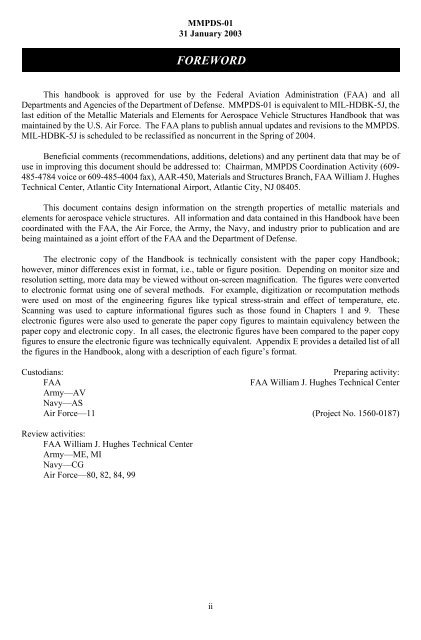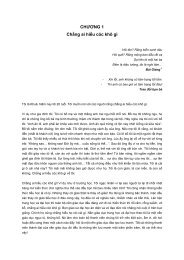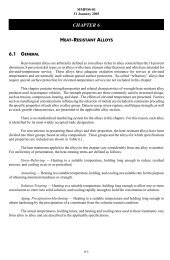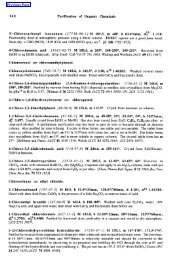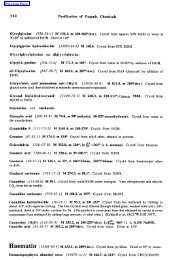Metallic Materials Properties Development and ... - Nouvelle page 1
Metallic Materials Properties Development and ... - Nouvelle page 1
Metallic Materials Properties Development and ... - Nouvelle page 1
Create successful ePaper yourself
Turn your PDF publications into a flip-book with our unique Google optimized e-Paper software.
MMPDS-01<br />
31 January 2003<br />
FOREWORD<br />
This h<strong>and</strong>book is approved for use by the Federal Aviation Administration (FAA) <strong>and</strong> all<br />
Departments <strong>and</strong> Agencies of the Department of Defense. MMPDS-01 is equivalent to MIL-HDBK-5J, the<br />
last edition of the <strong>Metallic</strong> <strong>Materials</strong> <strong>and</strong> Elements for Aerospace Vehicle Structures H<strong>and</strong>book that was<br />
maintained by the U.S. Air Force. The FAA plans to publish annual updates <strong>and</strong> revisions to the MMPDS.<br />
MIL-HDBK-5J is scheduled to be reclassified as noncurrent in the Spring of 2004.<br />
Beneficial comments (recommendations, additions, deletions) <strong>and</strong> any pertinent data that may be of<br />
use in improving this document should be addressed to: Chairman, MMPDS Coordination Activity (609-<br />
485-4784 voice or 609-485-4004 fax), AAR-450, <strong>Materials</strong> <strong>and</strong> Structures Branch, FAA William J. Hughes<br />
Technical Center, Atlantic City International Airport, Atlantic City, NJ 08405.<br />
This document contains design information on the strength properties of metallic materials <strong>and</strong><br />
elements for aerospace vehicle structures. All information <strong>and</strong> data contained in this H<strong>and</strong>book have been<br />
coordinated with the FAA, the Air Force, the Army, the Navy, <strong>and</strong> industry prior to publication <strong>and</strong> are<br />
being maintained as a joint effort of the FAA <strong>and</strong> the Department of Defense.<br />
The electronic copy of the H<strong>and</strong>book is technically consistent with the paper copy H<strong>and</strong>book;<br />
however, minor differences exist in format, i.e., table or figure position. Depending on monitor size <strong>and</strong><br />
resolution setting, more data may be viewed without on-screen magnification. The figures were converted<br />
to electronic format using one of several methods. For example, digitization or recomputation methods<br />
were used on most of the engineering figures like typical stress-strain <strong>and</strong> effect of temperature, etc.<br />
Scanning was used to capture informational figures such as those found in Chapters 1 <strong>and</strong> 9. These<br />
electronic figures were also used to generate the paper copy figures to maintain equivalency between the<br />
paper copy <strong>and</strong> electronic copy. In all cases, the electronic figures have been compared to the paper copy<br />
figures to ensure the electronic figure was technically equivalent. Appendix E provides a detailed list of all<br />
the figures in the H<strong>and</strong>book, along with a description of each figure’s format.<br />
Custodians:<br />
Preparing activity:<br />
FAA<br />
FAA William J. Hughes Technical Center<br />
Army—AV<br />
Navy—AS<br />
Air Force—11 (Project No. 1560-0187)<br />
Review activities:<br />
FAA William J. Hughes Technical Center<br />
Army—ME, MI<br />
Navy—CG<br />
Air Force—80, 82, 84, 99<br />
ii


